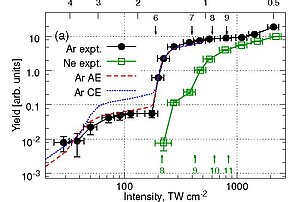Although with the Keldysh parameter, which was already introduced in the 1960s by the eponymous Russian physicist, a clear distinction was made between the multiphoton and tunnel image, it remains an open question whether, especially in the description of the excitation of atoms by intense laser fields that can be transformed into each other's two seemingly incompatible approaches.
The multiphoton character manifests itself e.g. in the presence of resonant increases in the excitation as soon as an integer multiple of the photon energy corresponds to the excitation energy of atomic states. However, one has to keep in mind that the atomic levels shift to higher energies with increasing laser intensity. As a result, resonant effects due to an increase in laser intensity occur even when the frequency of the laser radiation is fixed. These occur periodically, whenever the energy shift of the levels has increased by one photon energy. These areas are referred to as channel closing (completion of a multiphoton process with a fixed number of photons), since simultaneously with the increased excitation the ionization is suppressed.
In the tunnel image, the laser field is considered as an electromagnetic wave, of which only the oscillating electric field is considered. Excitation can be understood as a process in which the bound electron is initially released instantaneously through a tunneling process near the maximum of a field cycle. However, in many cases the electron does not absorb enough drift energy from the oscillation in the laser field in order to free itself from the Coulomb field of its fuselage at the end of the laser pulse, which would lead to the ionization of the atom. Instead, it finds itself in an excited Rydberg state again. In the tunnel image, no resonant effects in the excitation are possible because the laser field is assumed to be static for the tunneling process and thus the frequency of the light is initially insignificant.
